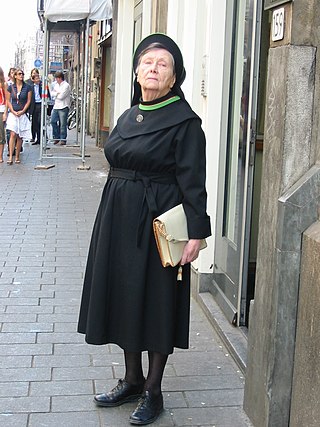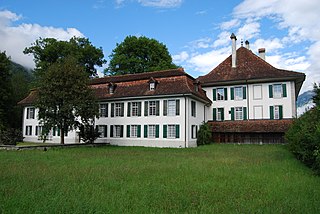Related Research Articles
The Benedictines, officially the Order of Saint Benedict, are a mainly contemplative monastic religious order of the Catholic Church for men and for women who follow the Rule of Saint Benedict. The male religious are also sometimes called the Black Monks, in reference to the colour of their religious habits, in contrast to other Benedictine orders such as the Olivetans, who wear white. They were founded in 529 by Benedict of Nursia, a 6th-century Italian monk who laid the foundations of Benedictine monasticism through the formulation of his Rule. Benedict's sister, Scholastica, possibly his twin, also became a religious from an early age, but chose to live as a hermit. They retained a close relationship until her death.

A monastery is a building or complex of buildings comprising the domestic quarters and workplaces of monastics, monks or nuns, whether living in communities or alone (hermits). A monastery generally includes a place reserved for prayer which may be a chapel, church, or temple, and may also serve as an oratory, or in the case of communities anything from a single building housing only one senior and two or three junior monks or nuns, to vast complexes and estates housing tens or hundreds. A monastery complex typically comprises a number of buildings which include a church, dormitory, cloister, refectory, library, balneary and infirmary, and outlying granges. Depending on the location, the monastic order and the occupation of its inhabitants, the complex may also include a wide range of buildings that facilitate self-sufficiency and service to the community. These may include a hospice, a school, and a range of agricultural and manufacturing buildings such as a barn, a forge, or a brewery.

The Carthusians, also known as the Order of Carthusians, are a Latin enclosed religious order of the Catholic Church. The order was founded by Bruno of Cologne in 1084 and includes both monks and nuns. The order has its own rule, called the Statutes, and their life combines both eremitical and cenobitic monasticism. The motto of the Carthusians is Stat crux dum volvitur orbis, Latin for "The Cross is steady while the world turns". The Carthusians retain a unique form of liturgy known as the Carthusian Rite.

A nun is a woman who vows to dedicate her life to religious service and contemplation, typically living under vows of poverty, chastity, and obedience in the enclosure of a monastery or convent. The term is often used interchangeably with religious sisters who do take simple vows but live an active vocation of prayer and charitable work.

The dissolution of the monasteries, occasionally referred to as the suppression of the monasteries, was the set of administrative and legal processes between 1536 and 1541, by which Henry VIII disbanded monasteries, priories, convents, and friaries in England, Wales, and Ireland; expropriated their income; disposed of their assets; and provided for their former personnel and functions.

A convent is a community of monks, nuns, friars or religious sisters. Alternatively, convent means the building used by the community. The word is particularly used in the Catholic Church, Lutheran churches, and the Anglican Communion.

The Bridgettines, or Birgittines, formally known as the Order of the Most Holy Savior, is a monastic religious order of the Catholic Church founded by Saint Birgitta in 1344 and approved by Pope Urban V in 1370. They follow the Rule of Saint Augustine. There are today several different branches of Bridgettines.

Christian monasticism is the devotional practice of Christians who live ascetic and typically cloistered lives that are dedicated to Christian worship. It began to develop early in the history of the Christian Church, modeled upon scriptural examples and ideals, including those in the Old Testament, but was not mandated as an institution in the scriptures. It has come to be regulated by religious rules and, in modern times, the Canon law of the respective Christian denominations that have forms of monastic living. Those living the monastic life are known by the generic terms monks (men) and nuns (women). The word monk originated from the Greek μοναχός, itself from μόνος meaning 'alone'.

Alien priories were religious establishments in England, such as monasteries and convents, which were under the control of another religious house outside England. Usually the mother-house was in France.

Wettingen-Mehrerau Abbey is a Cistercian territorial abbey and cathedral located at Mehrerau on the outskirts of Bregenz in Vorarlberg, Austria. Wettingen-Mehrerau Abbey is directly subordinate to the Holy See and thus forms no part of the Catholic Archdiocese of Salzburg. The abbot of Wettingen-Mehrerau, however, is a member of the Austrian Bishops' Conference. The official name of the abbey is Beatae Mariae Virginis de Maris Stella et de Augia Majore.

The Abbey Pax Mariae, more commonly referred to as Vadstena Abbey, situated on Lake Vättern in the Diocese of Linköping, Sweden, is a monastery of nuns within the Bridgettine Order. It was active from 1346 until 1595 and has been active since 1963, regaining status as an autonomous abbey in 1991.

Stanbrook Abbey is a Catholic contemplative Benedictine Monastery with the status of an abbey, located at Wass, North Yorkshire, England.

Augustinian nuns are the most ancient and continuous segment of the Roman Catholic Augustinian religious order under the canons of contemporary historical method. The Augustinian nuns, named after Saint Augustine of Hippo, are several Roman Catholic enclosed monastic communities of women living according to a guide to religious life known as the Rule of St. Augustine. Prominent Augustinian nuns include Italian mystic St. Clare of Montefalco and St. Rita of Cascia.
Thomas Cromwell established the Court of Augmentations, also called Augmentation Court or simply The Augmentation in 1536, during the reign of King Henry VIII of England. It operated alongside three lesser courts following the dissolution of the monasteries. The Court's primary function was to gain better control over the land and finances formerly held by the Roman Catholic Church in the Kingdom of England. The Court of Augmentations was incorporated into the Exchequer in 1554 as the Augmentation Office.

The Suppression of Religious Houses Act 1535, also referred to as the Act for the Dissolution of the Lesser Monasteries and as the Dissolution of Lesser Monasteries Act 1535, was an Act of the Parliament of England enacted by the English Reformation Parliament in February 1535/36. It was the beginning of the legal process by which King Henry VIII set about the Dissolution of the Monasteries.

Interlaken Monastery was a convent of the Augustinian Canons Regular from about 1133 until 1528 at Interlaken in the canton of Bern in Switzerland. It is a Swiss heritage site of national significance.

The Monastère de Chalais, also called Châlais-sur-Voreppe or Notre-Dame de Châlais, is a Dominican convent near the town of Voreppe, Isère, France. The convent dates from 1101.
Secularization is the confiscation of church property by a government, such as in the suppression of monasteries. The term is often used to specifically refer to such confiscations during the French Revolution and the First French Empire in the sense of seizing churches and converting their property to state ownership.
The Reduction of Gustav I of Sweden, was an important reform during the Protestant Swedish Reformation, in which king Gustav I of Sweden ordered a reduction in church property and the return of land to the crown, making the national church dependent upon the monarch and effectively ending Swedish monastic life. This organised confiscation and transfer of the property of the Swedish Catholic church to the Crown – initiated at the Västerås riksdag of 1527 and finalised in the 1540s – was the economic phase of the Swedish Reformation and was followed by the Örebro Synod, which dealt with theological matters.
References
- ↑ Gonzales, Michael J., The Mexican Revolution, 1910–1940, p. 203, UNM Press, 2002
- ↑ By Frank Tallett and Nicholas Atkin, Priests, Prelates and People: A History of European Catholicism Since 1750 (London and New York: I. B. Tauris, 2004), 12.
- ↑ National Assembly legislation cited in John McManners, The French Revolution and the Church, 27.
- ↑ John McManners, The French Revolution and the Church, 27.
- ↑ Censer and Hunt, Liberty, Equality, Fraternity: Exploring the French Revolution, 61.
- ↑ Emmet Kennedy, A Cultural History of the French Revolution, 148.
- ↑ Censer and Hunt, Liberty, Equality, Fraternity: Exploring the French Revolution, 92.
- ↑ Joe Kissell, The Grande Chartreuse, Itotd.com, 29 October 2018
- ↑ "La Grande Chartreuse". Catholic Encyclopedia .
- ↑ "La Grande Chartreuse". Immaculate Heart of Mary's Hermitage.
- ↑ ( "Church & Democracy". Time Magazine . Aug 19, 1940. Archived from the original on September 30, 2007. Retrieved 2002-02-24.)
- ↑ Lutherus, Martinus (1521). On Monastic Vows - De votis monasticis. Melchior Lotter d.J. / World Digital Library. Retrieved 2014-03-01.
- 1 2 3 4 Herbermann, Charles, ed. (1913). . Catholic Encyclopedia . New York: Robert Appleton Company.
- ↑ Webster's Encyclopedic Unabridged Dictionary of the English Language, 1989.
- ↑ Derek Beales, Prosperity and Plunder. European Catholic Monasteries in the Age of Revolution, 1650–1815, Cambridge University Press, 2003, p. 59.
- ↑ Whaley, J., Germany and the Holy Roman Empire (1493–1806), Oxford University Press, 2011, vol. 2, p. 623.
- ↑ The process of Catholic dispossession, monastic dissolution and re-use of the monastic premises was described by Jonathan Israel in "The Dutch Republic", Clarendon Press, Oxford, 1995
- ↑ Dawson, Scotland Re-Formed, 1488–1587, pp. 217–8.